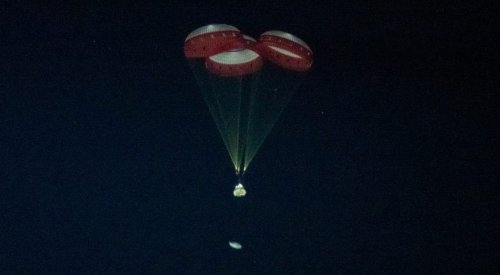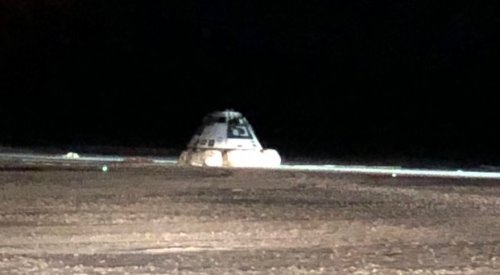WASHINGTON — Boeing’s CST-100 Starliner spacecraft landed safely in New Mexico in the early morning hours Dec. 22, wrapping up an uncrewed test flight cut short by a timer glitch.
Starliner landed at White Sands Missile Range in New Mexico at 7:58 a.m. Eastern, 35 minutes after performing a deorbit burn using its thrusters. The spacecraft “hit the bullseye” at the landing site, Boeing and NASA reported on a NASA TV broadcast of the landing.
The spacecraft’s reentry and landing appeared to go as planned, including the deployment of the spacecraft’s drogue and main parachutes. During a pad abort test at White Sands in November, one of three main parachutes failed to deploy because it was not properly rigged, but Boeing said they had identified the problem and ensured that the parachute on this spacecraft was properly set up.
“The landing looked exactly like we had in the simulations,” Boeing engineer Jim May said during the NASA TV broadcast. “A nice, soft landing.”
The landing brought an early end to a mission that had been scheduled to last more than a week. Original plans called for the Starliner to dock with the International Space Station Dec. 21 and remain there until shortly after midnight Eastern Dec. 28, undocking and landing at White Sands several hours later.
The Boeing CST-100 Starliner after a successful landing at White Sands, New Mexico. Credit: NASA
Those plans changed, though, when the spacecraft encountered a problem with its mission elapsed timer shortly after it separated from the Centaur upper stage of the Atlas 5 that launched it. The timer was not properly set, causing it to fire its attitude control thrusters at the wrong time and consuming too much propellant to permit an approach to the station.
The cause of the timer error remains under investigation. “Our spacecraft needs to reach down into the Atlas 5 and figure out what time it is,” Jim Chilton, senior vice president for Boeing’s space and launch division, said in a media teleconference Dec. 21. “We reached in and grabbed the wrong coefficient.”
Why that timer got the wrong information is not known. “We are surprised,” Chilton said. “A very large body of integrated tests, approved by NASA, didn’t surface this.”
NASA and Boeing worked to achieve as many mission objectives as they could without arriving at the ISS. That included testing communications between the spacecraft and ISS, checks of the spacecraft’s navigation system, and extending and retracting the spacecraft’s docking system.
It’s not immediately clear what effect the failure of the Starliner to reach the ISS will have on plans to perform a crewed flight test, which Boeing had hoped to carry out in the first part of 2020, including whether a second uncrewed flight test will be needed to carry out the objectives not completed on this flight.
- Starliner mission to end with Sunday landing
- Missing pin blamed for Boeing pad abort parachute anomaly
- SpaceX trumpets progress on commercial crew parachute testing
- Parachute development a challenge for commercial crew
- Five decades after Black Arrow, a reawakening UK launch industry aims for bullseye
Share with your friends


(0) Comments
This article comments are currently no :(